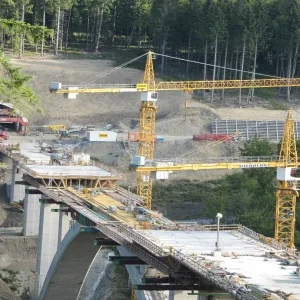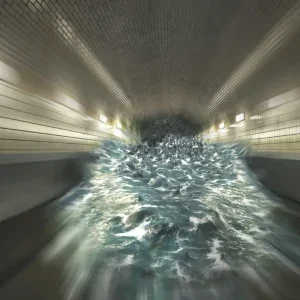
As the tunnelling industry increasingly adopts digital technologies and interconnected systems, the risk of cyber attacks has become a significant concern. Cyber attacks targeting tunnelling projects can lead to operational disruptions, data breaches, financial losses, and safety hazards. Combatting the risk of cyber attacks requires a proactive approach to cybersecurity, encompassing risk assessment, threat prevention, incident response, and employee training. This article explores strategies to mitigate the risk of cyber attacks in the tunnelling industry and safeguard critical infrastructure and data.
Understanding the Risks:
The tunnelling industry faces various cybersecurity risks, including:
- Operational Disruptions: Cyber attacks targeting tunnelling infrastructure, control systems, and operational technologies can disrupt project workflows, halt construction activities, and compromise safety-critical systems, leading to project delays and cost overruns.
- Data Breaches: Cyber attacks can result in unauthorized access to sensitive project data, proprietary information, and intellectual property, posing risks to confidentiality, integrity, and availability of data. Data breaches can damage reputations, undermine stakeholder trust, and expose organizations to legal and regulatory liabilities.
- Financial Losses: Cyber attacks, such as ransomware, phishing, and business email compromise (BEC), can result in financial losses through extortion, fraudulent transactions, and theft of funds. Financial impacts may include ransom payments, regulatory fines, legal fees, and loss of revenue due to operational downtime.
- Safety Hazards: Cyber attacks targeting tunnelling control systems, monitoring equipment, and safety-critical devices can pose safety hazards to workers, contractors, and the public. Compromised control systems may lead to accidents, malfunctions, or unauthorized access to hazardous materials, endangering lives and causing environmental damage.
Combatting Cyber Attacks:
To combat the risk of cyber attacks in the tunnelling industry, stakeholders can implement the following strategies:
- Conduct Cyber Risk Assessment: Perform comprehensive cyber risk assessments to identify potential vulnerabilities, threats, and impacts associated with tunnelling projects and digital infrastructure. Assess the security posture of IT and OT systems, network architecture, software applications, and third-party vendors to prioritize cybersecurity investments and mitigation efforts.
- Implement Cybersecurity Controls: Deploy robust cybersecurity controls and best practices to protect against common cyber threats, including malware, phishing, ransomware, and insider threats. Implement multi-factor authentication, encryption, access controls, network segmentation, and intrusion detection systems (IDS) to safeguard critical assets and data.
- Enhance Network Security: Strengthen network security measures to defend against unauthorized access, data exfiltration, and network intrusions. Implement firewalls, virtual private networks (VPNs), secure Wi-Fi networks, and security monitoring tools to monitor network traffic, detect anomalies, and block malicious activities in real-time.
- Secure Industrial Control Systems (ICS): Secure industrial control systems (ICS) and supervisory control and data acquisition (SCADA) systems used in tunnelling operations to prevent cyber attacks on operational technologies (OT). Segment OT networks from IT networks, apply security patches and updates regularly, and conduct security audits and penetration testing to identify and remediate vulnerabilities.
- Establish Incident Response Plan: Develop and implement an incident response plan (IRP) to effectively respond to cyber security incidents and minimize their impact on tunnelling projects. Define roles and responsibilities, establish communication protocols, and conduct regular tabletop exercises and incident simulations to test the effectiveness of the IRP and improve response readiness.
- Provide Cybersecurity Training: Provide cybersecurity awareness training and education to employees, contractors, and project stakeholders to enhance their understanding of cyber threats, best practices, and risk mitigation strategies. Train personnel on recognizing phishing emails, social engineering attacks, and security hygiene practices to prevent inadvertent security breaches.
- Ensure Third-Party Security: Assess and manage the cybersecurity risks posed by third-party vendors, contractors, and suppliers involved in tunnelling projects. Establish security requirements and contractual obligations for third parties, conduct due diligence assessments, and monitor compliance with cybersecurity standards and regulations.
- Stay Informed and Adapt: Stay informed about emerging cyber threats, vulnerabilities, and industry best practices through participation in information sharing forums, industry associations, and cybersecurity conferences. Continuously monitor and adapt cybersecurity strategies, technologies, and policies to address evolving cyber threats and regulatory requirements.
Case Studies and Best Practices:
To illustrate the effectiveness of these strategies, consider the following case studies and best practices from the tunnelling industry:
- Singapore Mass Rapid Transit (MRT) Tunnels: The Singapore MRT tunnelling project implemented robust cybersecurity controls and secure communication protocols to protect tunnel control systems from cyber attacks. Multi-layered security measures, including network segmentation, encryption, and intrusion detection, were deployed to safeguard critical infrastructure and ensure operational resilience.
- Crossrail Project, London, UK: The Crossrail project integrated cybersecurity requirements into procurement contracts and vendor agreements to address cyber risks across the supply chain. Third-party vendors were required to adhere to cybersecurity standards, undergo security assessments, and implement secure coding practices to mitigate supply chain vulnerabilities.
- Gotthard Base Tunnel, Switzerland: The Gotthard Base Tunnel project established a dedicated cybersecurity team and incident response capabilities to monitor, detect, and respond to cyber threats targeting tunnel control systems and operational technologies. Regular cybersecurity training and awareness programs were conducted for project personnel to foster a culture of cybersecurity awareness and vigilance.
Conclusion:
Combatting the risk of cyber attacks in the tunnelling industry requires a proactive and collaborative approach that integrates cybersecurity into project planning, design, construction, and operations. By conducting cyber risk assessments, implementing cybersecurity controls, enhancing network security, and providing cybersecurity training, stakeholders can mitigate cyber risks, protect critical infrastructure and data, and ensure the safety, security, and resilience of tunnelling projects in an increasingly digital world.







